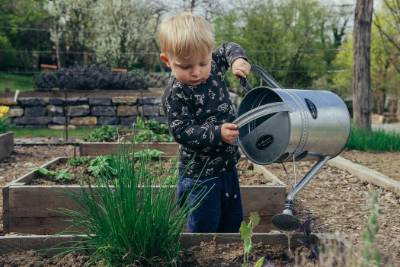Gardening with Children

Studies have found that introducing youth to gardening encourages them to eat a wider variety of fruits and veggies they haven’t tried before and the garden is a wonderful place to mix education and fun. Teaching youth about gardening doesn’t have to be limited to just the outdoors and our normal growing season, teaching youth how to take care of houseplants can teach a variety of lessons as well. Here are some tips on involving your kids in the garden and with plants.
One of the first lessons I learned was to start small and set realistic goals with kids and gardening. Break tasks down into smaller chunks, especially with young kids, to fit their attention span and interest levels. That might mean you only plant one row of corn at a time instead of the whole section or you only water a few plants indoors at a time. Setting realistic goals and activities will help you as the adult have fun and the kids have fun. When I first started gardening with my then toddler I skipped this step and the first few times we were in the garden ended in frustration on my part. Once I adjusted my expectations our ventures into the garden became fun for everyone. Your role in the garden should be as a facilitator rather than a dictator telling them how to do everything. Show the kids what you want done then walk them through and let them do it. There will be some messes but both of you will learn more from the messes than anything else.
Give your child a job. Kid’s, especially young kids love to help and to have a task that is theirs to do. Pick a task that will fit your child’s age and abilities, for example planting small seeds is probably not a good choice for a young child while planting potatoes or pumpkin seeds would work. Large seeds could be boring for an older child but smaller seeds can add a challenge that will keep their attention. Pick something that won’t impact the garden if they do mess up on accident. Other options of tasks include pulling weeds, shredding paper for mulch, watering or putting dirt in flower pots. At home my little guy loves to water so he has his own watering can and he waters the bigger plants that will tolerate getting a bit too much every once in a while.
As kids get older give them ownership in their garden. An excellent option is to give kids a small portion of the garden that is theirs for the summer. They get to pick what they want to grow then maintain that portion of the garden through out the growing season. Once the produce is ready to pick they get to choose where it goes once it’s harvested or how they want to eat it. Another way to give ownership is to put one kid in charge of a task such as running the wheel barrow or watering. As kids get older remember that gardening may become “uncool” and working with them one on one may work better than in a group.
Gardening should be a fun and educational activity for kids. Be sure to reflect with the kids after completing an activity. Depending on the age group this reflection period could be as simple as asking what was planted or what we did. As you work with your kids try to foster a sense of discovery and hands-on activities. Gardening can become dull and boring, especially toward the end of the growing season but take the time to encourage their natural curiosity. If you don’t know the answer to a question, take time to look it up and read books on gardening. Remember that in the garden you are their role model and what you do they will follow. Remember to show them how to be safe in the garden and read the labels of any products you are using. Go out and get dirty with your kids this summer because education shouldn’t be limited to the classroom.

Have questions? Contact our office where our Horticulture Extension Agent will assist you with questions.
Phone: (316) 321-9660
Email: callae@ksu.edu